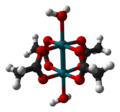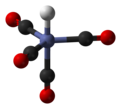Transition metal carboxylate complexes are coordination complexes with carboxylate (RCO2−) ligands. Reflecting the diversity of carboxylic acids, the inventory...
14 KB (1,490 words) - 05:17, 23 June 2025
Transition metal carboxylate complex Oxalatonickelate Krishnamurty, Kotra V.; Harris, Gordon M. (1961). "The Chemistry of the Metal Oxalato Complexes"...
9 KB (962 words) - 05:24, 23 June 2025
In coordination chemistry, a transition metal NHC complex is a metal complex containing one or more N-heterocyclic carbene ligands. Such compounds are...
5 KB (551 words) - 00:06, 21 June 2025
lacking direct metal-carbon bonds. Metal β-diketonates, metal alkoxides, metal dialkylamides, transition metal carboxylate complexes, metal acetylacetonates...
1 KB (180 words) - 13:35, 28 December 2023
Transition metal phosphate complexes are coordination complexes with one or more phosphate ligands. Phosphate binds to metals through one, two, three...
6 KB (610 words) - 17:52, 11 April 2025
In chemistry, a transition metal chloride complex is a coordination complex that consists of a transition metal coordinated to one or more chloride ligand...
61 KB (3,495 words) - 22:06, 16 June 2025
Rhodium(II) acetate (category Aqua complexes)
cyclopropanation of alkenes. It is a widely studied example of a transition metal carboxylate complex. Rhodium(II) acetate is usually prepared by the heating of...
6 KB (378 words) - 16:27, 15 February 2025
hemoglobin, hemerythrin, and hemocyanin. Several transition metals form complexes with O2, and many of these complexes form reversibly. The binding of O2 is the...
10 KB (1,086 words) - 09:15, 26 February 2025
A transition metal imidazole complex is a coordination complex that has one or more imidazole ligands. Complexes of imidazole itself are of little practical...
9 KB (1,011 words) - 18:37, 10 February 2025
classified as CMD, the transition state does not need to involve the carboxylate as a ligand on the metal. Common sources of carboxylate include pivalate,...
17 KB (1,781 words) - 05:28, 12 June 2025
Transition metal amino acid complexes are a large family of coordination complexes containing the conjugate bases of the amino acids, the 2-aminocarboxylates...
11 KB (1,220 words) - 22:15, 10 February 2025
Carboxylate–based metal–organic frameworks are metal–organic frameworks that are based on organic molecules comprising carboxylate functional groups. The...
27 KB (3,236 words) - 14:59, 22 May 2025
intramolecular variant of this reaction was first reported in 1961. Rhodium carboxylate complexes, such as dirhodium tetraacetate, are common catalysts. Enantioselective...
11 KB (1,251 words) - 02:35, 22 October 2024
Das cubane (category Cobalt complexes)
The Das cubane is a transition metal carboxylate complex with the formula [CoO(OAc)py]4 where OAc is acetate and py is pyridine. The compound is named...
2 KB (198 words) - 16:20, 23 August 2024
Metal carbon dioxide complexes are coordination complexes that contain carbon dioxide ligands. Aside from the fundamental interest in the coordination...
20 KB (2,223 words) - 10:38, 24 August 2023
pores. The most common transition metals employed in carboxylate-based frameworks are Cu2+ and Zn2+. Lighter main-group metal ions have also been explored...
189 KB (22,820 words) - 06:53, 10 June 2025
Tolstikov, S. E.; Ovcharenko, V. I. (2019). "Mononuclear Transition Metal Adamantane-1-Carboxylates". Russian Chemical Bulletin. 68 (9): 1669–1674. doi:10...
2 KB (118 words) - 09:15, 15 July 2024
was introduced by Georg Wittig in 1958. Ate complexes are common for metals, including the transition metals (groups 3-11), as well as the metallic or semi-metallic...
5 KB (574 words) - 14:56, 31 July 2023
iconic example of a compound with a metal-metal quadruple bond. Like several other transition metal carboxylate complexes, Mo2(O2CCH3)4 adopts a Chinese lantern...
6 KB (613 words) - 15:53, 5 July 2024
reacted with an alkali-metal amide such as sodium amide to form 2-aminopyridine. In the compound methyl 3-nitropyridine-4-carboxylate, the meta nitro group...
11 KB (1,303 words) - 11:44, 26 June 2025
Saponification is a process of cleaving esters into carboxylate salts and alcohols by the action of aqueous alkali. Typically aqueous sodium hydroxide...
12 KB (1,246 words) - 02:16, 25 May 2025
functional group: Transition metal salts, especially copper compounds, facilitate decarboxylation via carboxylate complex intermediates. Metals that catalyze...
12 KB (1,289 words) - 13:41, 26 May 2025
Ligand (section Metal–ligand multiple bond)
functional group that binds to a central metal atom to form a coordination complex. The bonding with the metal generally involves formal donation of one...
35 KB (3,356 words) - 09:12, 24 June 2025
Coordination polymer (section Transition metals)
difficult in part because of the complex effect of environment on electron density distribution. Transition metals are commonly used as nodes. Partially...
22 KB (2,538 words) - 19:04, 31 March 2025
Silver (redirect from Silver (metal))
whitish-gray, lustrous transition metal, it exhibits the highest electrical conductivity, thermal conductivity, and reflectivity of any metal. Silver is found...
95 KB (11,424 words) - 05:36, 25 June 2025
of complex: compounds formed by the interaction of a metal ion with a ligand and supramolecular complexes, such as host–guest complexes and complexes of...
60 KB (7,559 words) - 02:16, 16 June 2025
Metallacarboxylic acid (category Transition metals)
equilibria with the carboxylate anions, LnMCO2−. Metallacarboxylate esters (LnMCO2R) arise by the addition of alkoxide to metal carbonyl: [LnM-CO]+ +...
3 KB (323 words) - 02:11, 19 June 2024
Iron(III) chloride (category Coordination complexes)
known as ferrioxalate. Other carboxylate sources, e.g., citrate and tartrate, bind as well to give carboxylate complexes. The affinity of iron(III) for...
39 KB (3,914 words) - 06:08, 2 May 2025
a bidentate chelating ligand, forming complexes with many transition metals. Ruthenium and platinum complexes of bipy exhibit intense luminescence. 2...
5 KB (340 words) - 15:58, 21 April 2025















